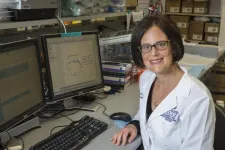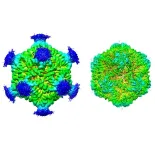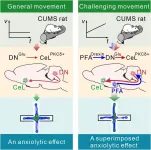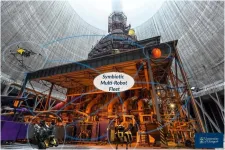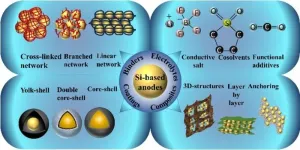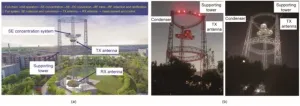(Press-News.org) (Boston)—Significant bleeding due to traumatic injury is the number one cause of preventable deaths in the U.S., with the majority of deaths occurring within six hours. Emerging evidence suggests that the transfusion of whole blood (blood that is not separated into parts) is associated with a survival benefit compared to the traditional use of blood component transfusion (red blood cells, plasma, and platelets) in these patients.
A new study from researchers from Boston University Chobanian & Avedisian School of Medicine demonstrates that the earlier one receives whole blood transfusion for severe traumatic bleeding, the greater chance of survival. However, if this transfusion was delayed by as little as 14 minutes after arriving at the hospital, the survival benefit was significantly reduced.
“These findings may lead to clinicians and hospital systems to consider whole blood as a standard emergency transfusion product incorporated into the massive transfusion protocol,” says corresponding author Crisanto Torres, MD, MPH, assistant professor of surgery at the school. “There may be a similar benefit for using whole blood transfusion at the scene of injury or during transport.”
The researchers analyzed 1,394 patients nationwide who presented to the emergency department with severe traumatic hemorrhage requiring massive transfusions, including whole blood, due to their traumatic injuries. They evaluated if the receipt of early whole blood transfusions was associated with improved survival at 24 hours and 30 days compared to delayed whole blood transfusions in severely bleeding trauma patients receiving component-based therapy massive blood transfusions. Those patients who received whole blood transfusion earlier upon their arrival to the emergency department had improved survival rates.
“Our study indicates a targeted time goal for whole blood administration within 14 minutes of hospital arrival. There is a decrease in survival probability for each minute delay in whole blood transfusion, but the most pronounced reduction in the probability of survival was seen after 14 minutes,” added Torres who also is a trauma surgeon at Boston Medical Center.
These findings appear online in JAMA Surgery.
END
Whole blood transfusion improves survival during traumatic bleeding
Timing of the initial whole blood transfusion, down to the minute, is connected to survival
2024-01-31
ELSE PRESS RELEASES FROM THIS DATE:
Combination drug therapy shows promise for a treatment-resistant cancer
2024-01-31
FOR IMMEDIATE RELEASE
A combination of two cancer drugs could be effective against malignant peripheral nerve sheath tumors (MPNSTs) — soft tissue tumors that are stubbornly resistant to chemotherapy and radiation — according to a laboratory study led by researchers at the Johns Hopkins Kimmel Cancer Center.
Both drugs interfere with cell growth and replication but have different mechanisms of action. Used together, they suppressed the growth of MPNSTs in mouse models of human disease, the researchers found. The findings were published ...
Decarbonizing the world’s industries
2024-01-31
Harmful emissions from the industrial sector could be reduced by up to 85% across the world, according to new research.
The sector, which includes iron and steel, chemicals, cement, and food and drink, emits around a quarter of global greenhouse gas (GHG) emissions - planet-warming gases that result in climate change and extreme weather.
This new study, led by the University of Leeds as part of its contribution to the UK Energy Research Centre (UKERC), found that decarbonising the sector is technically possible with a mix of “high and low-maturity” technologies - those that are tried and tested, along with upcoming tech that is not yet ready to be used in industry.
Lead ...
Brain protein’s virus-like structure may help explain cancer-induced memory loss
2024-01-31
In a rare but serious complication of cancer, the body’s own immune system can start attacking the brain, causing rapid-onset memory loss and cognitive deficits. What triggers this sudden biological civil war was largely unknown.
Now, researchers at University of Utah Health have found that some tumors can release a protein that looks like a virus, kickstarting an out-of-control immune reaction that may damage brain cells.
Their findings published in Cell on Jan. 31, 2024.
A rapid immune attack
Jason Shepherd, Ph.D., associate ...
Study finds brain mechanism for physical exercise improving mood
2024-01-31
"Only exercise can remove all kinds of doubts," Goethe said. Physical exercise is the lubricant between the body and the mind. Alleviation of anxiety by motor activity forms an integral part of our daily life; whether going for a walk to refresh our mind or running excessively in the park to recuperate from a stressful event, we are all well aware of the beneficial impact. In fact, the plain view that exercise can prevent anxiety and depression has been supported by accumulating prospective cohort studies in recent years. Yet, apart from some general interactions between the periphery of our body and our ...
Symbiotic autonomous robot ecosystem enhances safety and efficiency on nuclear facilities decommissioning
2024-01-31
Nuclear facilities, particularly during decommissioning, face significant challenges due to hazardous materials and environments. Traditional methods often rely heavily on human intervention, posing risks and inefficiencies. A groundbreaking research introduces a symbiotic autonomous robot ecosystem, designed to transform nuclear facility decommissioning. This innovative approach leverages a Cyber-Physical System (CPS) coordinated through a digital twin interface, significantly enhancing safety, efficiency, and operational awareness ...
Alleviate the drought in the east Hungarian plains
2024-01-31
Intensive agricultural cultivation and the resulting changes in soil structure cause low humidity in the near-surface air during heat waves in really dry years. As a result, summer cold fronts roar across the Plain without the usual thunderstorms and precipitation, researchers at the Institute of Geography and Earth Sciences at Eötvös Loránd University explain in a review of articles on topics ranging from geodynamics to soil science to meteorology what made the summer of 2022 so severe in the eastern part of the country.
In 2022, the 7-week period starting in mid-June was disastrous for eastern Hungary. Almost no rain fell for weeks, and in the eastern part of the country, ...
Researchers overview recent progress and challenges in silicon-based anode materials for lithium-ion batteries
2024-01-31
Research in recent years displays that several chemical modifications (binders, composite materials, and electrolytes) provide superior stability and enhance electrochemical performance in Si-based anodes in lithium-ion batteries (LIBs). Thus far, several different chemical interactions on structural alterations to Si-based anode materials have been tried to enhance Li+ kinetics, structural stability, and volume development control throughout the delithiation/lithiation process.
Despite significant advancements, Si and Si-based electrodes are still in their infancy and are still far from finding widespread practical use. Si-based anodes face some difficulties, including substantial ...
News on drug-induced skin swelling
2024-01-31
Angiotensin-converting enzyme inhibitors - ACE inhibitors for short - are effective antihypertensive drugs. They block the formation of the hormone angiotensin II, which plays a central role in the development of high blood pressure. On the other hand, these drugs increase the concentration of the vasoactive signaling substance bradykinin. Among other things, this can lead to acute swelling of the skin or mucous membranes. In general, such swellings are not life-threatening. However, if they affect the tongue, throat or larynx, angioedema can be life-threatening for the patient due to the potential risk of suffocation. Research to date suggests that susceptibility to such drug-induced angioedema ...
Innovation on the design, construction, and experiments of OMEGA-based SSPS prototype: The Sun-Chasing Project
2024-01-31
Space solar power satellite (SSPS) is a tremendous energy system that collects and converts solar power to electric power in space, and then transmits the electric power to earth, spacecraft, or moving targets via microwave. It is regarded as one of the most potential ways to solve the problem of energy crisis.
In 2022, a team of researchers from Xidian University in China has completed a full-link and full-system ground demonstration and verification system for an SSPS, named the Sun-Chasing Project. Their study, recently published in Engineering, introduces the design concept of OMEGA 2.0 SSPS, the related key technologies, and the development of ground demonstration ...
SCAI publishes expert consensus statement on management of calcified coronary lesions requiring intervention
2024-01-31
WASHINGTON—Coronary artery calcification is increasing in prevalence, leading to greater risks both during procedures such as percutaneous coronary intervention (PCI) and adverse events in the short and long term. Along with these challenges, treatment options are expanding, increasingly including calcium modification prior to stent implantation. A newly published SCAI Expert Consensus Statement on the Management of Calcified Coronary Lesions outlines methods for interventional cardiologists to identify various types of calcified coronary lesions ...
LAST 30 PRESS RELEASES:
Diversifying US Midwest farming for stability and resilience
Emphasizing immigrants’ deservingness shifts attitudes
Japanese eels, climate change, and river temperature
Pusan National University researchers discover faster, smarter heat treatment for lightweight magnesium metals
China’s 2024 Gastroenterology Report: marked progress in endoscopy quality and disease management
Pusan National University researchers uncover scalable method for ultrahigh-resolution quantum dot displays
Researchers use robotics to find potential new antibiotic among hundreds of metal complexes
Gut bacteria changes at the earliest stages of inflammatory bowel disease
Scientists develop new way to “listen in” on the brain’s hidden language
Brain research: “Pulse generators” grow and shrink as memories are formed
For teens, any cannabis use may have impact on emotional health, academic performance
School meals could unlock major gains for human and planetary health
Menopause hormone therapy does not appear to impact dementia risk
Signature patterns of brain activity may help predict recovery from traumatic brain injury
Dresden study uncovers new key mechanism in cancer cells
New species are now being discovered faster than ever before, study suggests
Cannabis-based products show limited short-term benefit for chronic pain, with increased risk of adverse effects
Cannabis products with more THC slightly reduce pain but cause more side effects
Clearing the brain of aging cells could aid epilepsy and reduce seizures
Brain injuries linked with potential risk of suicide, new study finds
New technique lights up where drugs go in the body, cell by cell
New study finds movement of fishing fleets can reveal shifts in marine ecosystems
Embargoed: New evidence points to potential treatment for vascular dementia
Study uncovers disrupted brain balance in alcohol dependence
Working in groups can help Republicans and Democrats agree on controversial content moderation online
Structural findings reveal how distinct GPCR ligands create different levels of activation
Anything-goes “anyons” may be at the root of surprising quantum experiments
UC review: Maximizing workplace opportunity for veterans
From generation to complex control: Metasurfaces make perfect vortex beams "within reach"
Thin-film lithium niobate-based detector: recent advances and perspectives
[Press-News.org] Whole blood transfusion improves survival during traumatic bleedingTiming of the initial whole blood transfusion, down to the minute, is connected to survival
